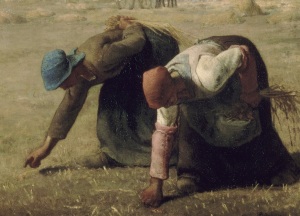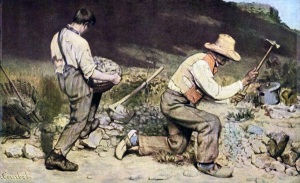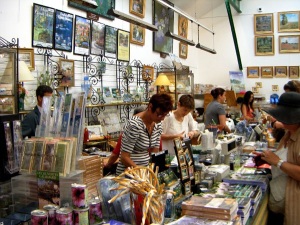If you ever wanted to get into the artist Jean-François Millet, the place to start would be “The Gleaners”, 1857. It is probably his best known work and the one of the most cherished examples of Realism painting. The scene depicts the ancient right of poor women to scour the wheat fields after harvest and collect and bits of edible wheat that remain. The painting shows three figures, hunched over in perpetual labour, hard working for a menial meal. The triad and the triangle in painting is one that brings a feeling of balance – the triad of women rise in front of us like a sturdy mountain. Indeed, their own forms are drawn to the ground like mountains, ever rooted in the soil.

“What does The Gleaners show? [The women] embody an animal force deeply absorbed by a painstaking task. The contrast between wealth and poverty, power and helplessness, male and female spheres is forcefully rendered.” – Liana Vardi
Even if you aren’t familiar with the process of gleaning there are visual cues in the process to tell the story ; we can see the hay being harvested and piled up in the background, indicating to us that the harvest has already occurred and the women are engaged after. In addition, the contrast of the heaping piles of plentiful food hovers over them, almost danging above their heads as a strong reminder of their situation. The gleaners themselves are hunched and tired looking, their skin darkened from the sun as a testament to their unending labour.

Their faces are obscured from us shrouding their identity and allowing the gleaner to act as a placeholder for all impoverished women. They’ve collected but mere handfuls of grain as the sun is setting, an indicator of the small reward for such a difficult and lengthy task. But the work is not in condemnation of the gleaners, instead the warmth of the golden light shines gracefully upon them as they are presented to us in impressive scale compared to the “privileged” in the background.
“[They] have gigantic pretensions, they pose as the Three Fates of Poverty, their ugliness and their grossness unrelieved” 1.
“Part of the shock value of Millet’s painting was undoubtedly due to the fact that in the past gleaning had usually been represented in art through the Old Testament tale of Ruth the gleaner, in which Ruth is characterized as a modest and virtuous example of the way to God, and not – as it was now – a statement on rural poverty” 2. There is both a literal and metaphorical disconnect between labourer and upper class as exemplified by the master on horseback (top right) who is leading the harvest but not participating. He is shaded and solitary, not involved in the scene, and physically set apart from any work being done, yet he represents the consumer, both in food and class.

When the Gleaners was submitted to the salon of 1857, the reception was disapproving, even hostile, especially among the upper classes (the usual patrons and audience of art). “To them, it was a reminder that French society was built upon the labor of the working masses, and landowners linked this working class with the growing movement of Socialism” 3. The work was viewed as a glorification of poor subjects and idolization of rural life, a common theme in Millet’s work. This theme and subsequent raw depiction and admiration is nowadays widely revered and respected but was generally rejected at the time of its debut, and the painting sold for much less than the asking price. Millet desperately needed the money, but in his embarrassment tried to keep the pathetic sale price a secret from the public.

Two Peasant Women Digging in the Snow, April, 1890
Foundation E.G. Bührle, Zurich, Switzerland.
Not much later, Van Gogh idolized and drew inspiration from Millet. Rural scenes were important in Van Gogh’s work both on a cultural and psychological level. Van Gogh did over twenty copies of Millet, especially during his self-admitted stint in Saint-Paul asylum which his brother thought Vincent created his best work. These paintings interpret the symbolism of Millet’s rural scenes and translate subjects into his own style. Van Gogh did in fact copy the Gleaners but reworked the scene into women digging in a field of snow. The work takes on a futile and uncomfortable aspect, changing what they dig through to something illustrative of that which is barren and hostile.
“One does not expect to get from life what one has already learned it cannot give; rather, one begins to see more clearly that life is a kind of sowing time, and the harvest is not yet here.” 4

Another very famous work is “The Angelus” (Millet), 1859, also at Museé d’Orsay. It depicts a rural scene of two peasants standing in a field with gentle illumination from the sunset. They are gently bowed, praying over a basket of potatoes. This simple painting is another depiction of the humble and righteous peasant. It was commissioned by Thomas Gold Appleton, who never collected it. It is about half the size of the Gleaners, and sold for less than half the price, so you can imagine Millet’s embarrassment. It was finally shown in 1874, a year before Millet’s death, and by the end of the century had completely about-faced in reception. It sold in 1889 for 553 000 francs5 (originally sold for 1000), the highest price for a modern painting to date. Only a month later, The Gleaners sold for 300,000 francs. Posthumous fame is a common theme in art history, and in this case owes itself in part Millet’s oeuvre, which was exhibited and auctioned after his death6. “They presented an artist whose works depicted “the man and the woman of the field in all the states of their lives. [Millet] admirably shows developments from infancy to youth, from youth to maturity, from maturity to old age, with the most solid logic and precise observation, with no more bias toward ugliness than toward beauty” 7.

An interesting side note is the Dali’s fascination with this painting, which led him to create a series of works and writings exploring his horrific associations and dark obsession with the Angelus. Dali was convinced that the work was sinister on some other level. Dali experienced hallucinations where he could see the painting in his mind but his interpretation was changed and distorted. Dali became convinced the painting was a funeral scene and that the two figures were playing over a child-sized coffin. Dali eventually convinced the Louvre to conduct an x-ray of the painting and discovered a small coffin-shaped object between the figures, which had been painted over with the basket of potatoes, presumably to make it more saleable. In his book The Tragic Myth of Millet’s Angelus Dali “recounts an instance in which a man knifed the Angelus and was put in an insane asylum, and uses that anecdote to make a point about the painting’s unpredictable power: exactly what David Freedberg and Leo Steinberg were to chronicle over forty years later. [… He also wrote] an essay explaining “Why They Attack the Mona Lisa”; [wherein] it divides assailants into “ultra–intellectuals” such as Duchamp, and “more-or-less Bolivians” who throw “pebbles,” or just steal the image” 8.

The Angelus is similar in composition to the Gleaners, in that the background extends out and away from the subject. Millet is said to have drawn inspiration by the memory if having to recite the Angelus prayer upon hearing the toll of the church bell9. However the tiny indication of the church, fading away in the background serves to both to indicate the context in which the subject should be considered, but also physically depicts the physical and representational distance between them. “Millet pictured not the rift that modernization had driven between rustics and the land but a nostalgic union of humankind and nature”10. What is foremost delineated are the two figures engaged in solemn thanksgiving within the sustenance borne of the soil. “The shift in attitude toward Millet, The Gleaners, and The Angelus in France owed not to the workings of the marketplace but to nostalgia and to the creation of a fluid republican national identity in France in the generation after the Franco-Prussian War and the Paris Commune” 11. The socio-political upheaval uncertainty in France encouraged the public to take solace in the simple and unchanging rural scene, and the direct relationship between need and satisfaction ie)hunger/food, purpose/job.

Similarly, there are other examples of rural idolatry from this era, including “Ploughing in Nivernais” (Rosa Bonheur), 1850. Bonheur, in contrast to Millet, enjoyed a great deal of success in her lifetime. “Photographic realism is the hallmark of her work, yet she rises far above mere photographic representation. She was intelligent, conscientious, & hard working. She believed in honesty in art & kept as close to nature as she could” 12. Bonheur studied animal anatomy and osteology and dedicated her life to the honest and factual depiction of animals. She was met with wide success of her realistic rural depictions. Nivernais was a commission awarded to her by the Second Republican government of France. “The inspiration for this famous painting may be from a novel by George Sand, the pen-name of Baroness Dudevant (1804-1876). In “The Devil’s Pool” (1846), she wrote about the displacement of peasants and farmers by industrialization, and espoused a return to nature” 13.
 another example, Boeufs allant au labour, effet de matin (Troyon, Constant) 1855.
another example, Boeufs allant au labour, effet de matin (Troyon, Constant) 1855.
In contrast to Millet, however the scene was not interpreted as a critique of the upper and middle classes, it was instead thought of as an loving depiction of simple life and stability, ideals which were yearned for within France. Unlike Millet’s Gleaners and Angelus, they are not bathed in golden warming light, they are illuminated in cold, clear light as if to indicate there is no question to the motivation or appreciation of the subject, it is purely Realism. “It is primarily an animal scene, whose heroes are the horse themselves, leaving little room for the man: the herdsman is very small on the canvas. It is a hymn to work in the fields whose magnitude is even more magnified it is easy to oppose, in the aftermath of revolution, the depravity of the city” 14. The public’s desires for stability and tranquility was reflected in their artistic interests. “They found solace in their image of what they considered unchanging: country life. In Labourage they see the sunny blue sky, the hills and moving oxen create a comfortable flow across the canvas. There is harmony between man and beast” 15.
1 “Story behind the picture – The Gleaners”. University of St. Andrews. Retrieved 2008-01-10.
2 http://www.st-andrews.ac.uk/~waste/timeline/story-pic1.html
3 Kleiner, Fred; Christian J. Mamiya. Gardner’s Art Through the Ages (12 ed.). California: Wadsworth/Thompson Learning. 2005.
4 Erickson, K. At Eternity’s Gate: The Spiritual Vision Of Vincent van Gogh. Grand Rapids, MI: William B. Eerdsman Publishing. 1998. pp. 150–151.
5 W. Walton et al., Chefs-d`oeuvre de l`exposition universelle de Paris, 1889 (Philadelphia: George Barrie, 1889), 53.
6, 10, 11 http://www.mutualart.com/OpenArticle/France-Embraces-Millet–The-Intertwined-/65DB908A334354D8
7 Theophile Silvestre. Catalogue des 95 dessins de J.-F. Millet composant la collection de M. Gavet (Paris: Pillet, 1875) ; and Catalogue de la vente qui aura lieu par suite du deces de Jean-Francois Millet, peintre, sale cat., Hotel Drouot, Paris, May 10-11, 1875.
8 http://305737.blogspot.fr/2013/03/chapter-81-salvador-dali.html
9 http://www.musee-orsay.fr/index.php?id=851&L=1&tx_commentaire_pi1%5BshowUid%5D=339
12, 15 http://ringlingdocents.org/pages/bonheur.htm
13 http://www.themasterpiececards.com/famous-paintings-reviewed/bid/18772/Famous-Paintings-Plowing-in-the-Nivernais
14 http://www.musee-orsay.fr/fr/collections/oeuvres-commentees/recherche/commentaire/commentaire_id/labourage-nivernais-31.html






























